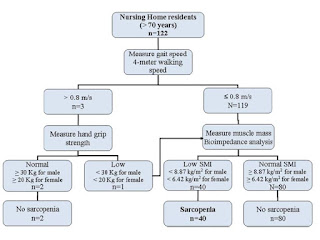老人ホームでのサルコペニアの有病割合とリスク因子を調査した論文を紹介します。
Landi F, Liperoti R, Fusco D, Mastropaolo S, Quattrociocchi D, Proia A, Russo A, Bernabei R, Onder G: Prevalence and risk factors of sarcopenia among nursing home older residents. J Gerontol A Biol Sci Med Sci. 2012 Jan;67(1):48-55.
サルコペニアの診断基準は下記のように、European Working Group on Sarcopenia in Older People (EWGSOP)のものを用いています。筋肉量低下はBIA、筋力低下は握力、身体機能低下は4m歩行速度で評価しています。
結果ですが、老人ホーム入所中の70歳以上の高齢者のうち、32.8%がサルコペニアと判定されました。男性68%、女性21%と明らかな性差を認めました。その他のリスク因子として、脳血管疾患、変形性関節症、BMI21以下、余暇の身体活動が1日1時間以下を認めました。
なお、4m歩行速度の平均値は全体で0.14±0.20m/sですので、歩行不可の方が少なからず存在していることが推測されます。また、握力の平均値は全体で8.2±6.8kgで、0kgに近い方もいると思われます。BMIの平均値は全体で21.7±4.5、アルブミンは3.12±0.52g/dlでした。
イタリアの老人ホームで32.8%がサルコペニアであれば、日本の老人ホームでは大半がサルコペニアと判定されるのではないかと推測します。サルコペニアの診断基準ができてまだ日が浅いので、日本でもいろんな施設で有病割合をみる研究が行われるとよいと思います。
Abstract
BACKGROUND AND AIMS:
Sarcopenia has been indicated as a reliable marker of frailty and poor prognosis among the oldest individuals. At present, there are no data on sarcopenia in nursing home population. We evaluated the prevalence of sarcopenia and its association with functional and clinical status in a population of elderly persons aged 70 years and older living in nursing homes.
METHODS:
This study was conducted selecting all the participants (n = 122) living in the teaching nursing homes of Catholic University of Rome who were aged 70 years and older from August 1, 2010, to September 30, 2010. The European Working Group on Sarcopenia in Older People (EWGSOP) criteria were adopted. Accordingly, diagnosis of sarcopenia required the documentation of low muscle mass plus the documentation of either low muscle strength or low physical performance.
RESULTS:
Forty residents (32.8%) were identified as affected by sarcopenia. The multivariate logistic regression analysis showed a high increase in risk of sarcopenia for male residents (odds ratio [OR] 13.39; 95% confidence interval [CI] 3.51-50.63) and for residents affected by cerebrovascular disease (OR 5.16; 95% CI 1.03-25.87) or osteoarthritis (OR 7.24; 95% CI 2.02-25.95). Residents who had a body mass index higher than 21 kg/m(2) had a lower risk to be sarcopenic (OR 0.76; 95% CI 0.64-0.90) relative to those with body mass index less than 21 kg/m(2). Similarly, sarcopenia was less likely to be present among participants involved in leisure physical activity for 1 hour or more per day (OR 0.40; 95% CI 0.12-0.98).
CONCLUSIONS:
The present study suggests that among participants living in nursing homes, sarcopenia is highly prevalent and it is more represented among male residents (68%) than among female residents (21%). Our findings support the hypothesis that muscle mass is strongly associated with nutritional status and physical activity in nursing homes, too.
2012年3月29日木曜日
登録:
コメントの投稿 (Atom)





若林先生 僕も最近サルコペニア研究の執筆をするにあたってヨーロッパのサルコペニア診断基準というのを目にすること多くなりました。アメリカのよりも厳密なのか丁寧な分け方というイメージがあります。ヨーロッパの方がこの手の研究進んでるのでしょうか。ちなみに日本ではどのような分類になってるのですか?それとも統一基準が無いのでしょうか?素人質問で申し訳ありませんが、もしご存知でしたら教えて下さい。
返信削除P.S. 今日実験室にこもりっきりで、メールの返信で
きませんでした。お仲間の先生とも一緒に食事
したいと思います。是非誘って下さい!
佐久間先生、どうもありがとうございます。
返信削除私はこの数年程度しかわかりませんが、アメリカよりヨーロッパのほうがサルコペニアの研究は進んでいる印象があります。
日本では「サルコペニア研究会」のような組織がなく、日本独自の分類はないのが現状です。ヨーロッパ(EWGSOP)かSCWD(Society on Sarcopenia,Cachexia and Wasting Disorders)の分類のどちらかを使用するのが現実的で、私は前者を好んでいます。
日本独自と言えるのは、下記の真田先生が筋肉量のカットオフ値を示した「日本人成人男女を対象としたサルコペニア簡易評価法の開発論文」くらいでしょうか…。
http://www.jstage.jst.go.jp/article/jspfsm/59/3/291/_pdf
食事会の件、どうもありがとうございます。よろしくお願い申し上げます。
若林先生 丁寧な回答ありがとうございました。やはりヨーロッパの方が研究は進んでるのですね。。。J Cachexia Sarcopenia Muscleのような雑誌がヨーロッパを中心に展開され始めたこと、この分野の著名人にヨーロッパの方が多いことからそんな風に感じてました。
返信削除「サルコペニア研究会」ですか。。面白そうですね。メールやり取りしてても、ブログを見ても若林先生くらい知識がある(志が高い)方は国内にそうそういないと思います。先生が中心に展開できれば、面白い学会になりそうですね。この学会がもしできるのなら、基礎研究分野の立場で、是非参加させて下さいね!
佐久間先生、早々にどうもありがとうございます。
返信削除「サルコペニア研究会」はあったら面白いと思いますが、私は研究実績が皆無に近いので会員の一人で十分です(笑)。当面は日本リハ栄養研究会で頑張ります!